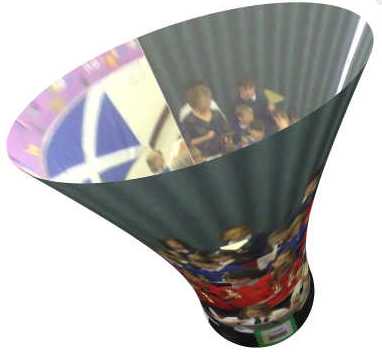Ring in Schools - Music Education through handbells, handchimes or belleplates
 The handbell as a musical instrument today provides a wonderful educational tool for teaching music to children. Effective use of handbells involves teaching children music and performance skills. The skills learned through ringing are transferable to any instrument.
The handbell as a musical instrument today provides a wonderful educational tool for teaching music to children. Effective use of handbells involves teaching children music and performance skills. The skills learned through ringing are transferable to any instrument. But just what makes using handbells as the musical medium such an effective music teaching tool? Well, for one thing, handbells make instant music. Within five minutes of starting ringing children can be playing chords to accompany a melody sung or played on a piano.
Handbells require no tuning on the part of a player so they can start to make music right away making this an instrument which is accessible to all.
Children also very much enjoy the fact that they make music in a group – they learn together how to make the instrument play in the correct place at the correct time, they learn with others the values of notes on the printed page, and they work as a team to replicate rhythmic patterns. The interaction with others adds to the fun – whether it is learning rhythmic syllables, note values, or music notation, all are introduced and reinforced with games. Being a part of a handbell group fosters community and co-operation.
 The teaching techniques used to teach ringing can incorporate aspects of well-respected music methods. Schools can incorporate aspects of the Kodály method, which breaks down musical skills and concepts into steps and introduces them gradually, but also constantly reviews and reinforces them through games, movement, and exercises and the use of rhythmic syllables (such as those of Aimé Paris – such as taa, ta-té, etc). The Dalcroze method also emphasises that movement is an important tool for the internalization of rhythm, and handbell ringing is very much a kinaesthetic activity – where children learn by listening, watching and actively playing – a note is played with a physical movement of the handbell, and the sound is also stopped by another physical movement of the handbell as it damps against the shoulder.
The teaching techniques used to teach ringing can incorporate aspects of well-respected music methods. Schools can incorporate aspects of the Kodály method, which breaks down musical skills and concepts into steps and introduces them gradually, but also constantly reviews and reinforces them through games, movement, and exercises and the use of rhythmic syllables (such as those of Aimé Paris – such as taa, ta-té, etc). The Dalcroze method also emphasises that movement is an important tool for the internalization of rhythm, and handbell ringing is very much a kinaesthetic activity – where children learn by listening, watching and actively playing – a note is played with a physical movement of the handbell, and the sound is also stopped by another physical movement of the handbell as it damps against the shoulder. Ostinato patterns, echo, improvisation and other techniques associated with the Orff approach can also be incorporated.
The reinforcement of music skills is a part of the progression from a beginning group. As well as musical games, exercises and activities, from the outset the children learn to perform music for audiences. Thus the development of performance skills takes its place alongside working on reading from a music score and adding expression. The music can range from music created by music educators to demonstrate musical concepts all the way through to energetic arrangements of theme music from movies.
 A typical session is active throughout with a variety of games and activities to teach or reinforce musical knowledge, as well as working on expression and technique in a previously-learned piece of music, sight-reading new music, honing in on tiny sections of music which involve complex rhythms, or memorising sections to allow performers to focus on the directions of the conductor.
A typical session is active throughout with a variety of games and activities to teach or reinforce musical knowledge, as well as working on expression and technique in a previously-learned piece of music, sight-reading new music, honing in on tiny sections of music which involve complex rhythms, or memorising sections to allow performers to focus on the directions of the conductor. With children’s groups the emphasis is on laying the foundations for being able to read music and perform for an audience. As all children progress, the many and varied techniques of ringing are introduced and developed, as is the ever-increasing musicianship where simply playing the correct note at the correct time is only the start. Increasingly complex music with a greater part played by each individual ringer marks a progression from beginner to advanced ringer. Subtle shades, the ebb and flow of music to convey feeling and engagement with an audience are the aims of all of the groups.
Click here for some ideas for the use of handbells, handchimes or belleplates in schools.
Watch the video below to see the use of belleplates by a primary school:
Watch the video below to see the use of handbells by a high school:
Watcht the video below for a primary class using handchimes
Watch the video below for a primary school combining handchimes, handbells and untuned percussion
Notes:
[i] Zoltán Kodály (1882-1967) was a Hungarian composer, musicologist and educator.
[ii] Rhythm syllables are also called 'French time names' and are designed to allow the voice to mimic the patterns of rhythms used in music.
[iii] The French time names were devised in the 19th century by Émile-Joseph Chevé (1804-1864), his wife Nanine Paris (died 1868), her brother Aimé Paris (1798-1866) and Pierre Galin (1786–1821).
[iv] Émile Jaques-Dalcroze (1865 - 1950) was a Swiss musician and music educator.
[v] An ostinato is a rhythmic pattern or part of a tune which is persistently repeated.
[vi] Carl Orff (1895 - 1982) was a German composer who become very influential in the field of music education for his teaching theories.